VERY RARE! Original "The Easter Offensive of 1972" U.S. Army Vietnam War “Indochina Monographs” Operational Report - From Brigadier General George E. Barker Collection

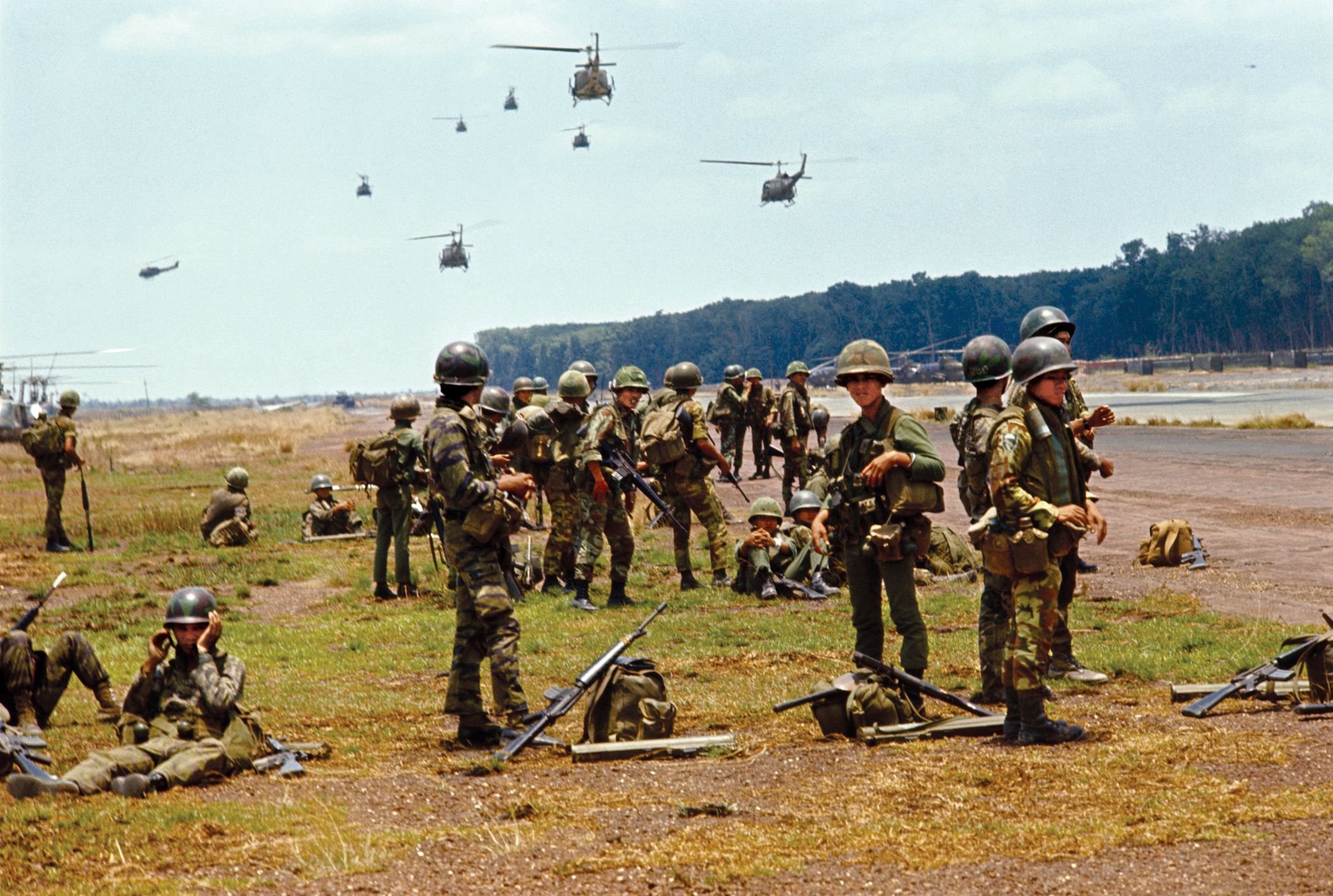
















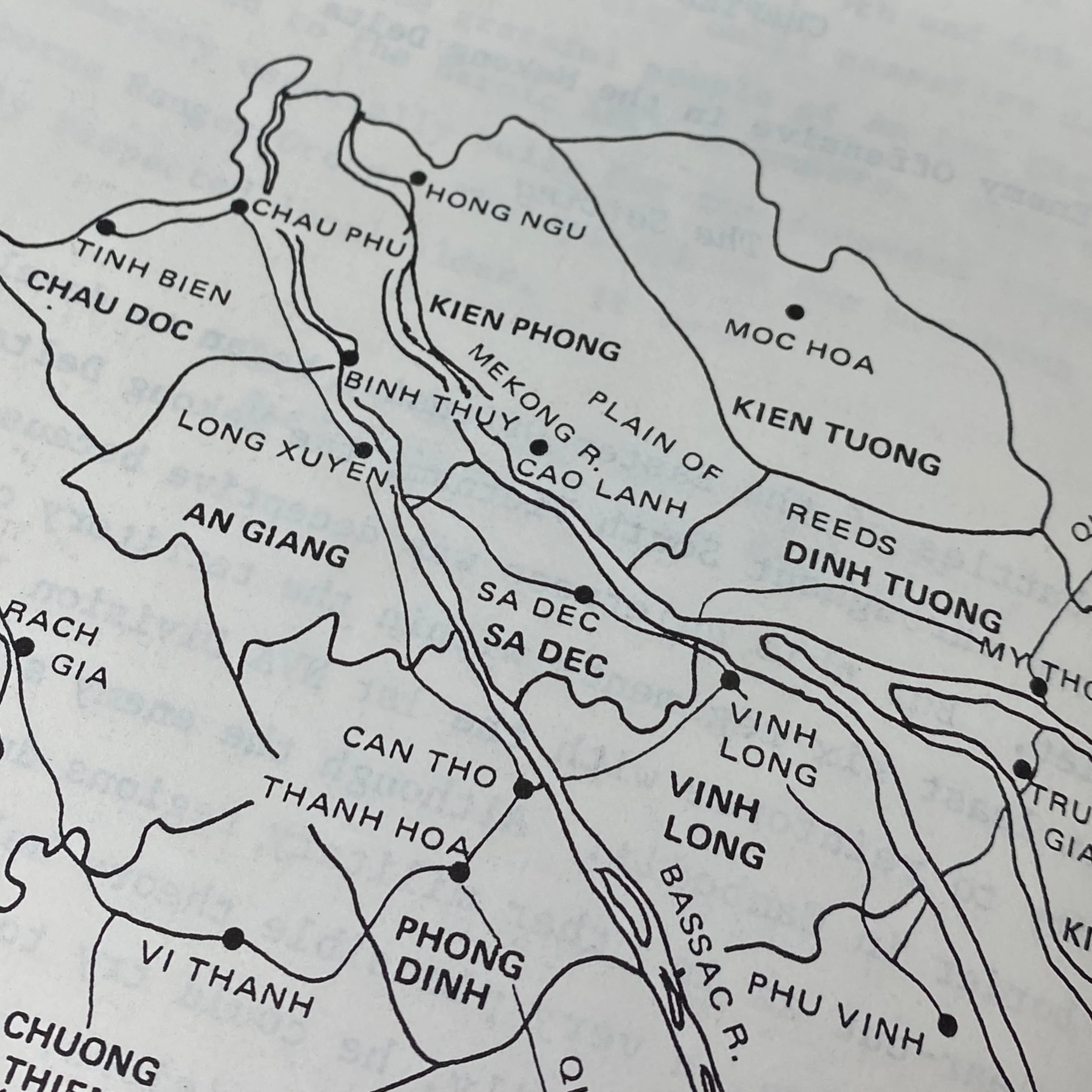











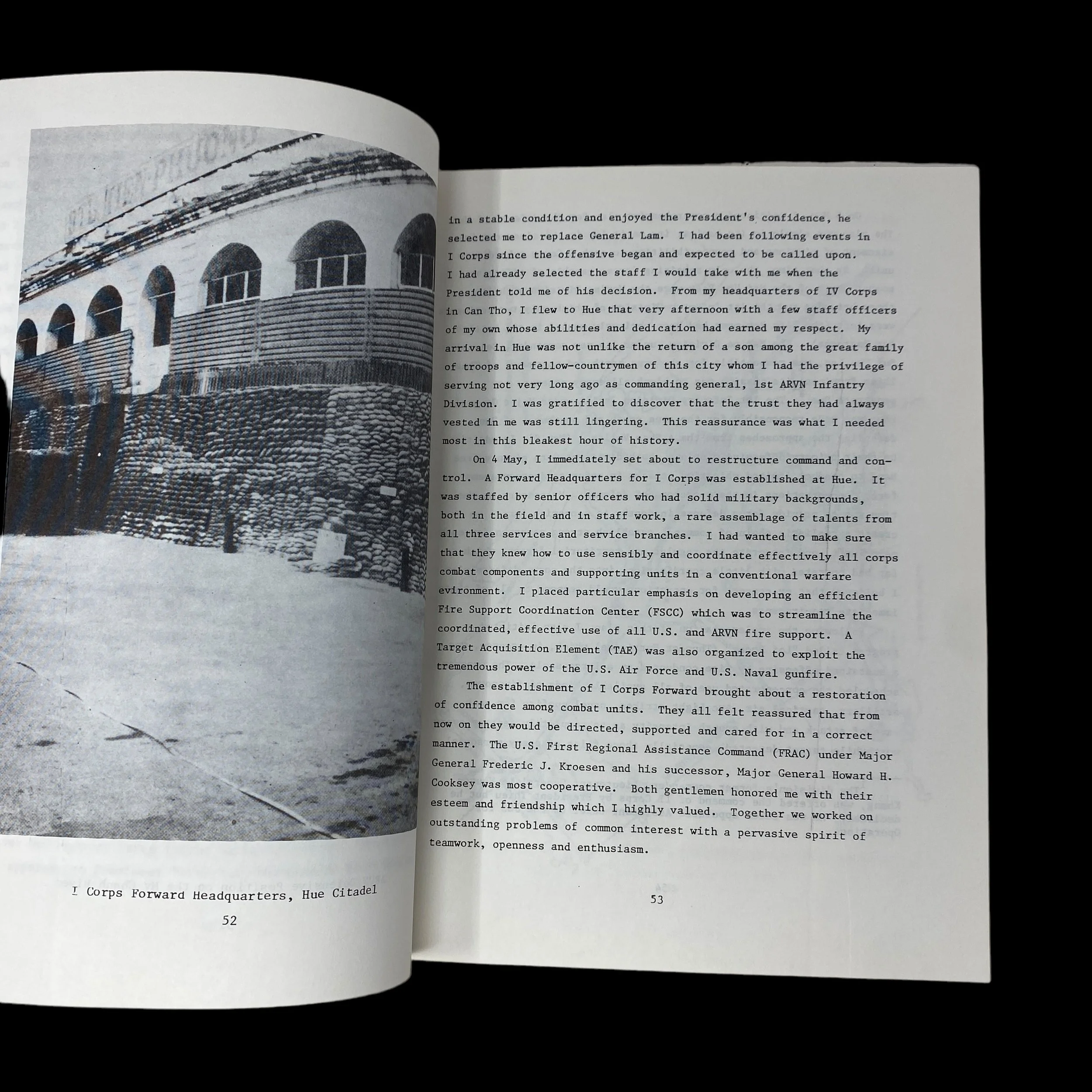










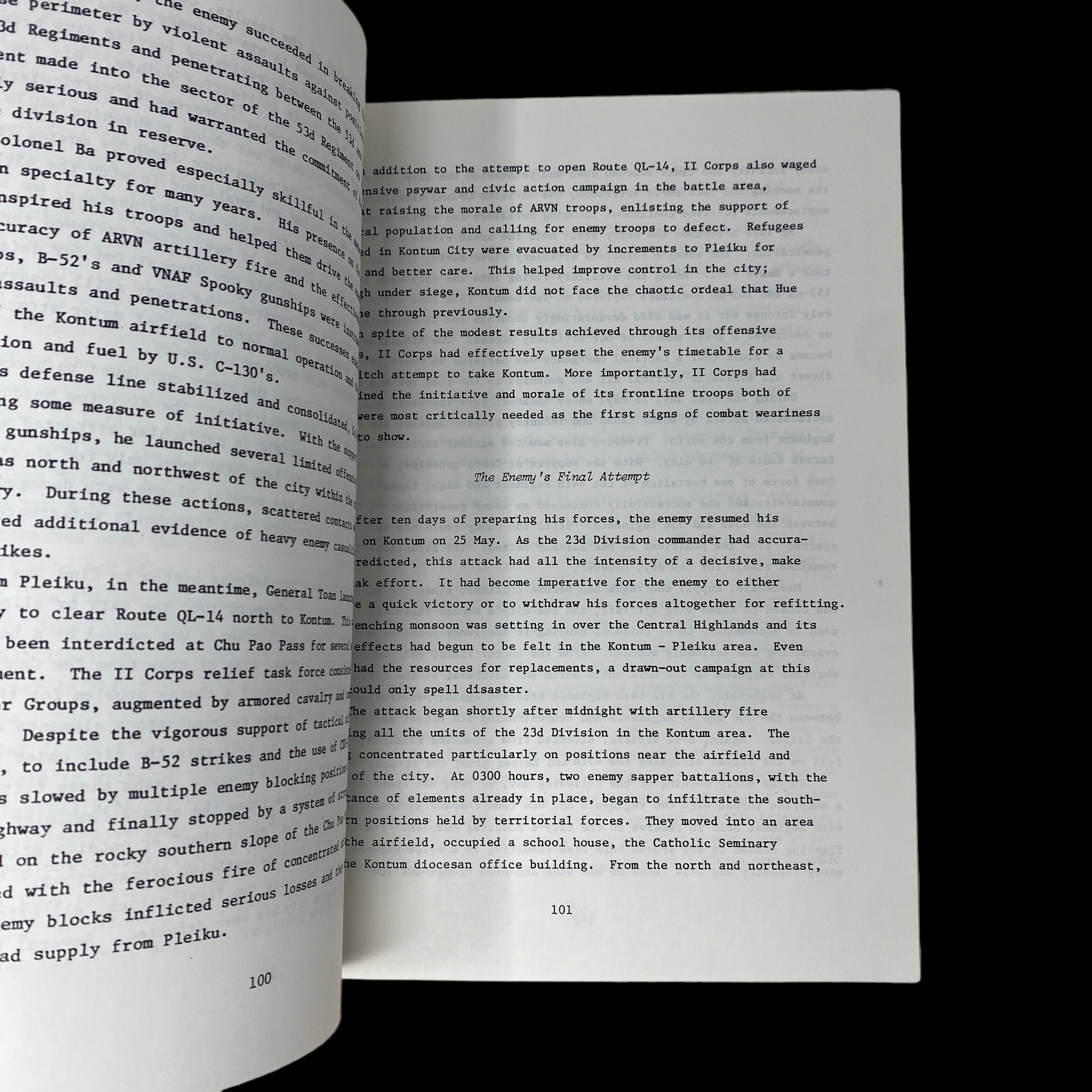






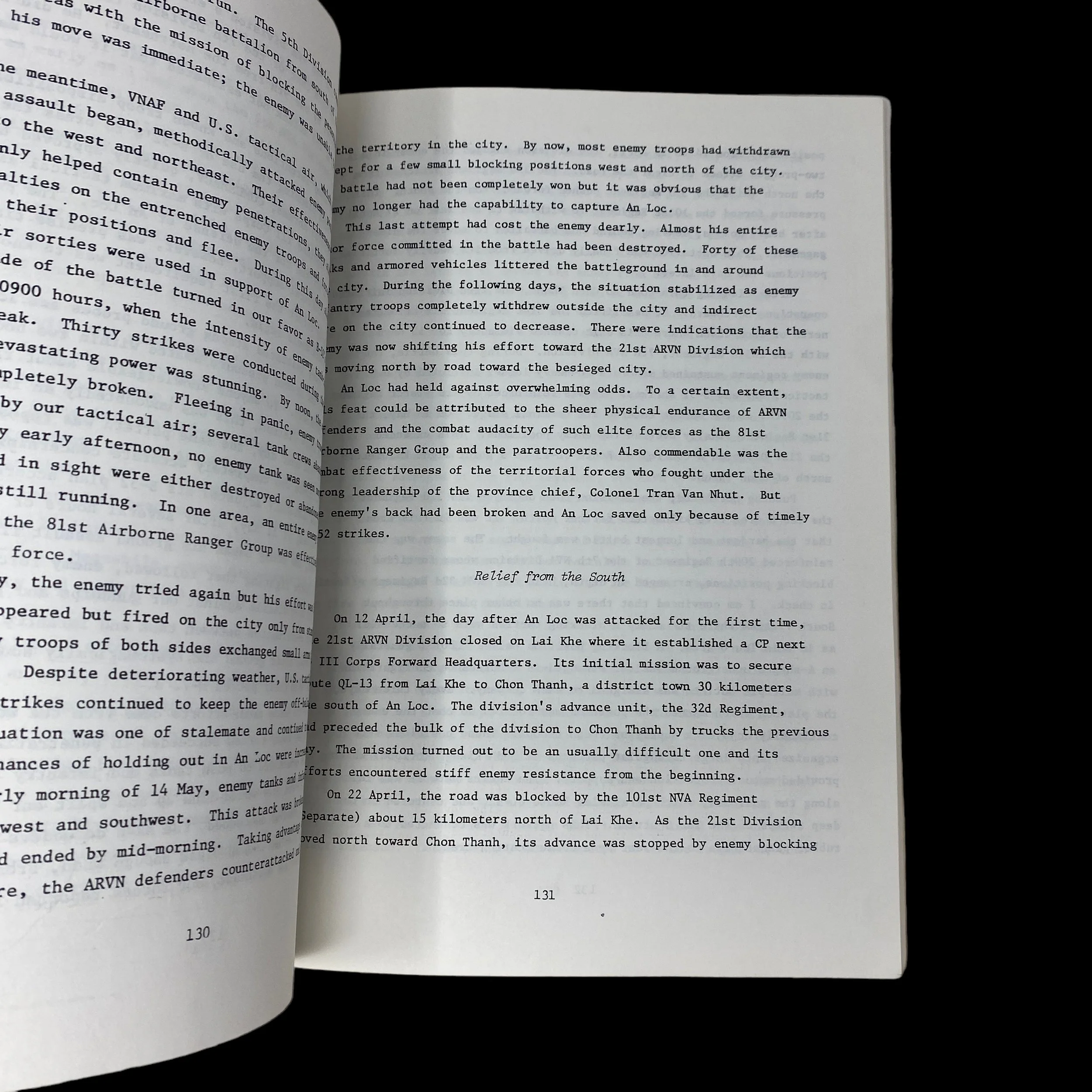




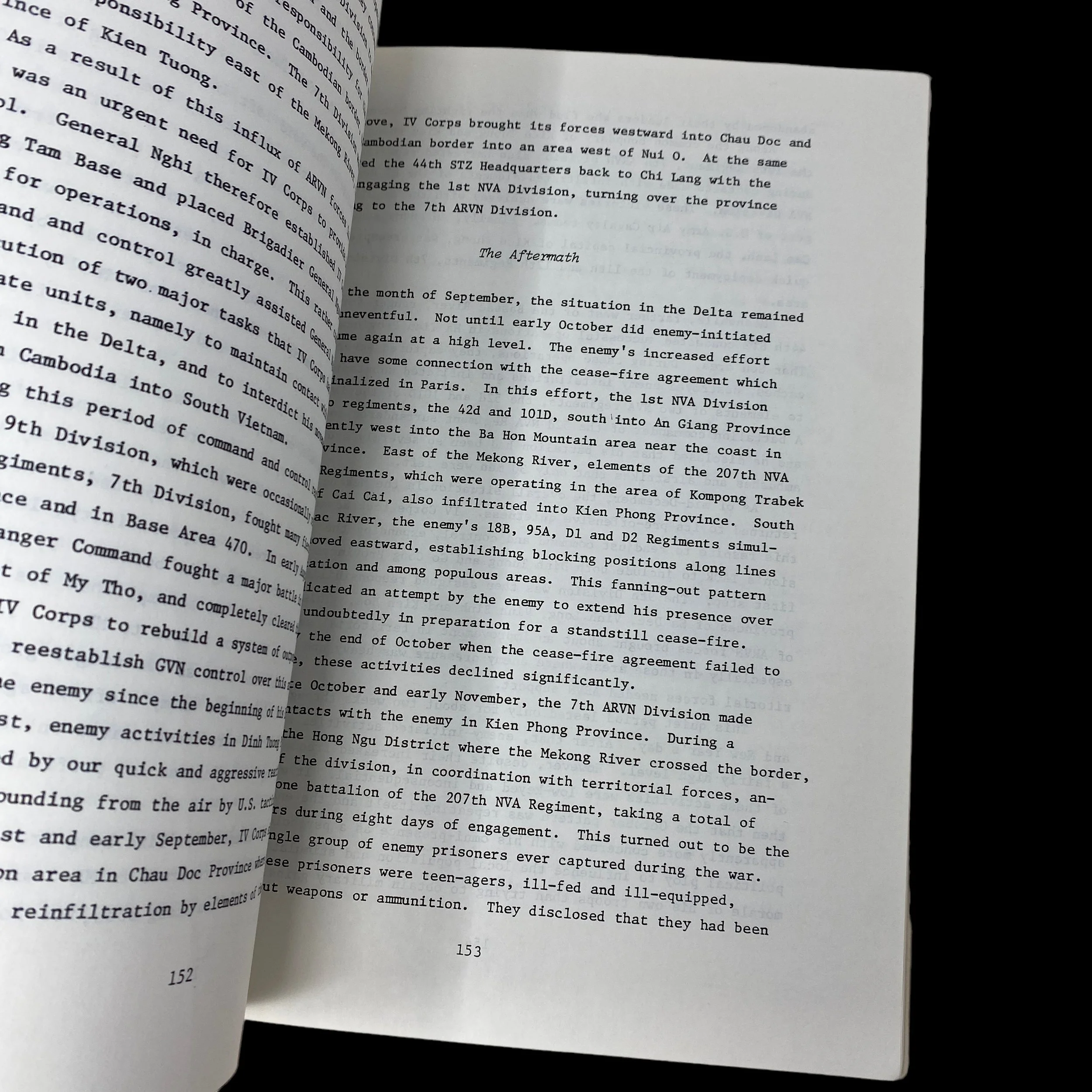



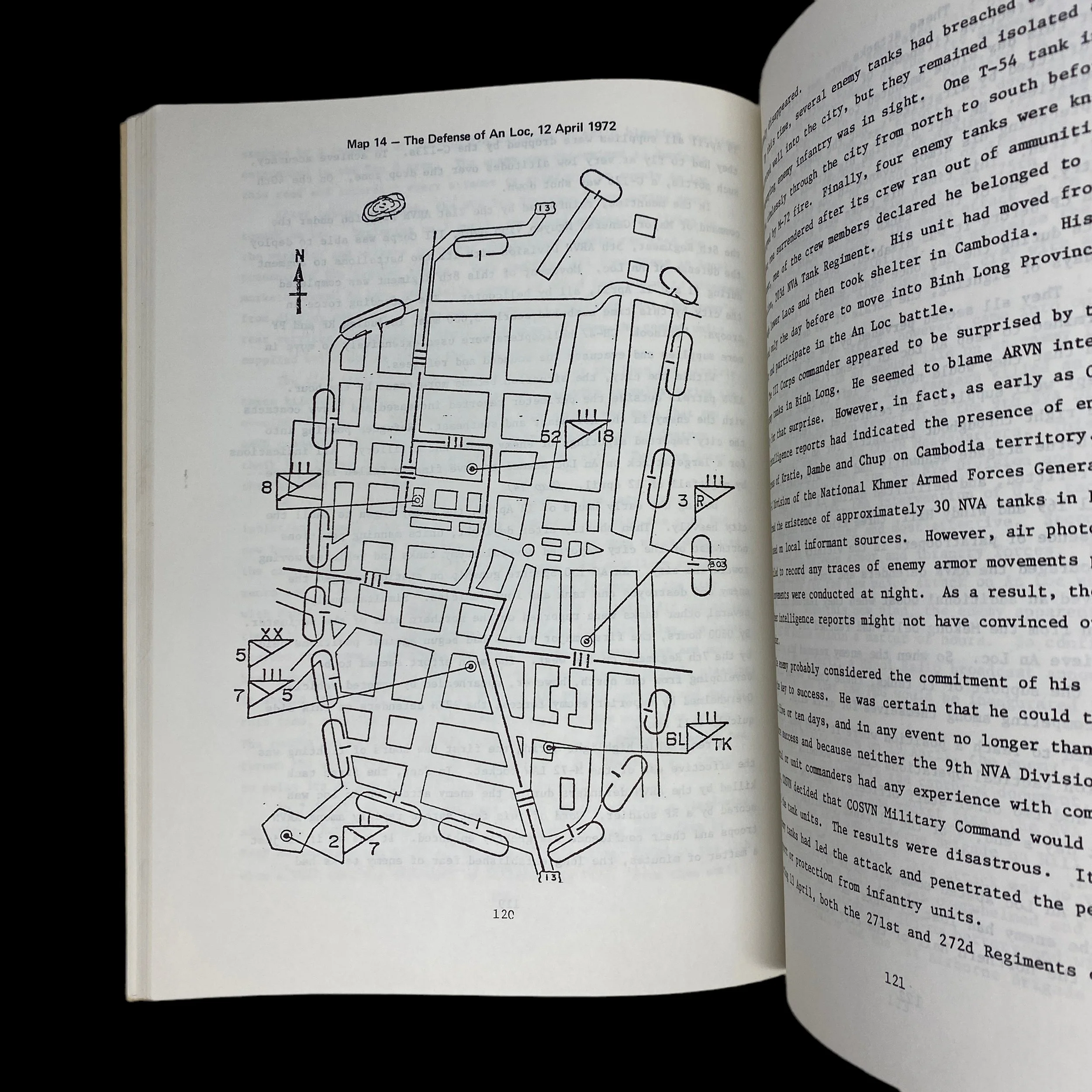




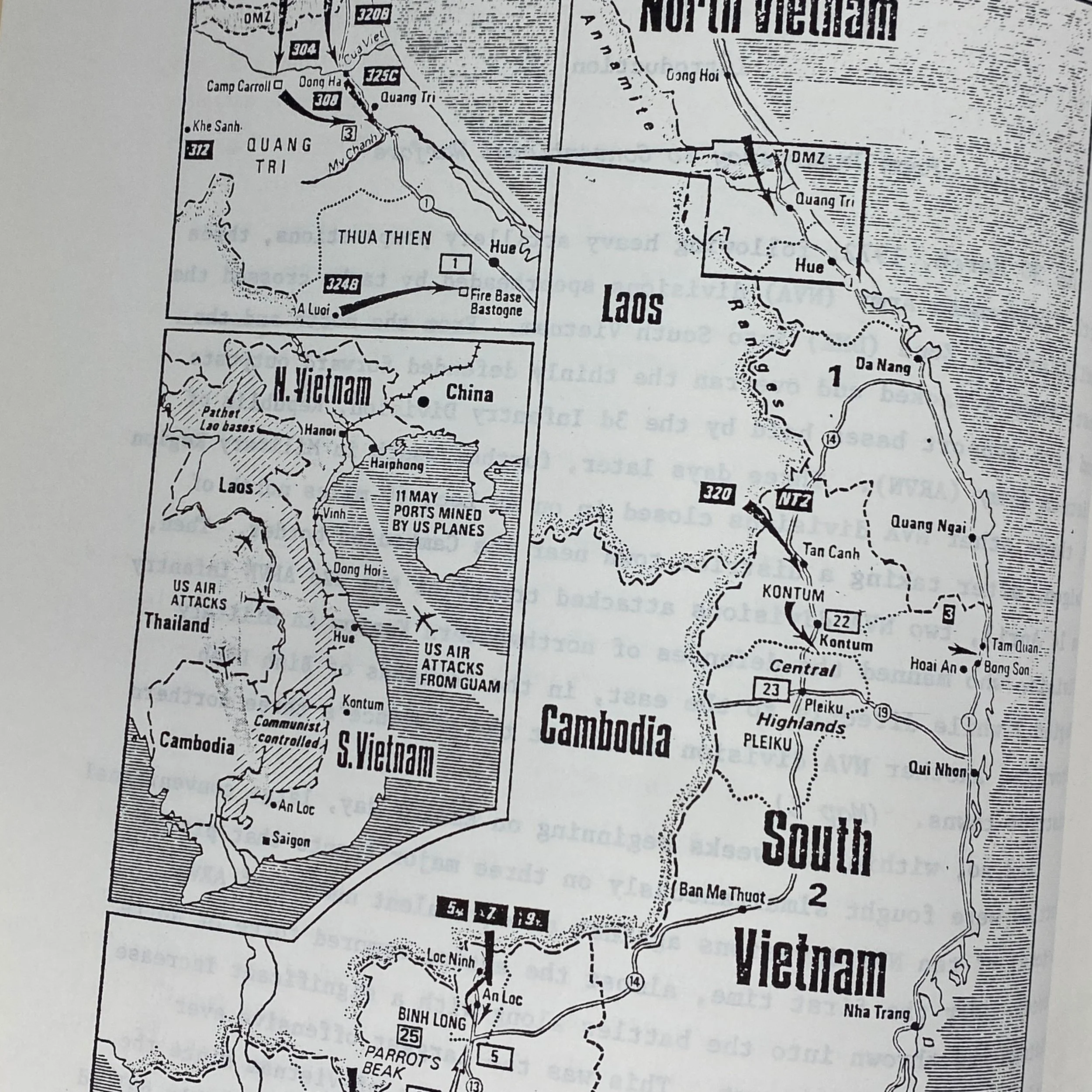


VERY RARE! Original "The Easter Offensive of 1972" U.S. Army Vietnam War “Indochina Monographs” Operational Report - From Brigadier General George E. Barker Collection
Comes with a hand-signed C.O.A.
*Once-in-a-lifetime chance to own an original and very limited U.S. Army print of the Vietnam War “Indochina Monographs” series directly from the private collection of Brigadier General George E. Barker.
Title: The Easter Offensive of 1972
Invasion of Quand Tri, Stabilization and Counteroffensive, Defending Kontum, The Seige of An Loc, Enemy Offensive. of the Mekong Delta, A Critical Analysis, Summary and Conclusions.
19 Maps
11 Illustrations
Page Total: 183
This extremely rare and museum-grade artifact is an original very limited early printing of the Vietnam War “Indochina Monographs” operational reports published by the U.S. Army Center of Military History (Washington D.C.).
Titled “THE EASTER OFFENSIVE OF 1972 - Lt. Ngô Quang Trưởng” this Indochina Monograph report was written by officers who held positions in the Cambodia, Laotian, and South Vietnamese armed forces during the Vietnam War in Indochina.
This specific report of the Indochina Monographs was written with intelligence and first-hand accounts from Ngô Quang Trưởng who was an officer in the Army of the Republic of Vietnam (ARVN). Trưởng gained his commission in the Vietnamese National Army in 1954 and moved up the ranks over the next decade, mostly in the Airborne Brigade. In 1966, Trưởng commanded a division for the first time after he was given command of the 1st Division after helping to quell the Buddhist Uprising. He rebuilt the unit after this divisive period and used it to reclaim the city of Huế after weeks of bitter street fighting during the Tết Offensive.
This original Vietnam Wa “Indochina Monographs” operational report series was produced in very limited quantities, however, what makes this particular report even rarer is that this report comes directly from the private collection of Brigadier General George E. Barker when he was issued this report during his command of the 407th Civil Affairs Battalion.
As noted in the Monograph series by Brigadier General Douglas Kinnard (Cheif of Military History) the Vietnam War “Indochina Monographs” operational report series show one of the most extensive and detailed views of the Vietnam War as it was not edited or altered to reflect the view of the U.S. Army or the Department of Defense.
GENERAL NGO QUANG TRUONG: REPUBLIC OF VIETNAM’S FINEST COMMANDER:
Ngo Quang Truong was widely considered one of the most honest and capable generals of the South Vietnamese army during the long war in Southeast Asia. General Bruce Palmer, in his book The 25-Year War, described Truong as a “tough, seasoned fighting leader” and “probably the best field commander in South Vietnam.” General Creighton Abrams, who commanded American military operations in Vietnam from 1968-72, told subordinates that he thought General Truong was capable of commanding an American division.
RISING STAR
Ngo Quang Truong was born December 19, 1929, to a well-to-do family in the Mekong Delta province of Kien Hoa. After he graduated from My Tho College, a French colonial-run school, Truong attended the reserve officer school at Thu Duc. He graduated with Class 4 and received his commission as an infantry officer in the Vietnamese National Army (VNA) in 1954. After graduation,Truong went immediately to airborne school in Da Lat. Upon completion of parachute training, he was assigned as commander of 1st Company, 5th Airborne Battalion. He helped rebuild the battalion,which had been decimated fighting alongside French forces at the1954 Battle of Dien Bien Phu.
In 1955, Truong and his unit participated in the operation to eliminate the Binh Xuyen river pirates who were vying with President Ngo Dinh Diem’s government for control of Saigon and the surrounding area. For his actions during that operation, Truong was awarded a battlefield promotion to first lieutenant. Later that year, after the Republic of Vietnam was created, the VNA became the Army of the Republic of Vietnam (ARVN).
Truong was promoted to captain in 1963, and just a year later he was promoted to major and appointed commander of 5th Airborne Battalion. During that same year, the battalion conducted a heliborne assault into the Do Xa Secret Zone in Minh Long district, Quang Ngai province. The operation was in response to the growing insurgency mounted by the North Vietnam-supported National Liberation Front (NLF, or Viet Cong). The subsequent attack by Truong’s battalion shattered the base area of the Viet Cong’s B-1Front headquarters and resulted in the capture of 160 weapons of all types. During this operation, Truong continued to build his growing reputation as a charismatic leader who led from the front and took care of his soldiers.
In 1965, 5th Airborne Battalion, still under Truong’s command,conducted a helicopter assault into the Hac Dich Secret Zone in the area of Ong Trinh Mountain in Phuoc Tuy (Ba Ria) province, the base area of the communist NLF’s 7th Division. After two days of fighting during which his battalion inflicted heavy losses on two enemy regiments, Truong was given a battlefield promotion to lieutenant colonel and was also awarded the Republic of Vietnam’s National Defense Medal, 4th Class.
After the Hac Dich battle, Truong was assigned as chief of staff of the Airborne Brigade. In late 1965, he was appointed as chief of staff of the Airborne Division. As historian Dale Andrade points out, this noncombat position might have stagnated Truong’s career, but his reputation for bravery and fairness got him noticed by the top brass in Saigon. General Cao Van Vien, Chief of the South Vietnamese Joint General Staff from 1965-75, later described Truong as “one of the best commanders at every echelon the Airborne Division ever had.”
In 1966, when violent civil disorders broke out in Central Vietnam by Buddhists protesting military control of the government, Truong was appointed as acting commander of ARVN 1st Infantry Division in Hue. As a Buddhist, he was uncomfortable commanding a unit charged with quelling the Buddhist demonstrations, but he carried out his duties with his customary professionalism, and Saigon subsequently made his appointment as division commander permanent.
Truong, with his usual brand of hands-on leadership, quickly molded the division, which did not have a very good reputation prior to his arrival, into one of the best units in the South Vietnamese army. Marine Lieutenant General Robert E. Cushman, commander of III Marine Amphibious Force in South Vietnam’s I Corps region, and his principal subordinate, Army General Richard G. Stilwell, commander of U.S. XXIV Corps, both felt that because of Truong’s efforts, ARVN 1st Division became “equal to any American unit.”
Truong’s American adviser at the time wrote that Truong was “dedicated, humble, imaginative and tactically sound.” His performance was noticed by Military Assistance Command, Vietnam (MACV) commander General William C. Westmoreland, who later wrote that Truong “would rate high on any list of capable South Vietnamese leaders.”
In 1967, units of 1st Infantry Division under Truong’s command, including the Black Panther (Hac Bao) Reconnaissance Company, 2d Troop/7th Armored Squadron, and the attached 9th Airborne Battalion, attacked and destroyed the Viet Cong infrastructure and a large number of local guerrilla forces of the Luong Co-Dong Xuyen-My Xa Front in Huong Tra district, Thua Thien province. After this battle, Truong was promoted to brigadier general.
TET OFFENSIVE
During the Communist Tet Offensive of 1968, General Truong commanded ARVN 1st Division during some of the bloodiest fighting of the Vietnam War in the Battle of Hue. Two nights before the offensive began, Truong, at his headquarters compound in the Citadel within Hue, Vietnam’s old Imperial Capital, sensed that something was amiss and put his troops on alert. When the night passed uneventfully, he dismissed his U.S. advisers but kept his troops ready.
The battle began at 3:30 a.m. on January 31, 1968, with two battalions of 6th North Vietnamese Army (NVA) Regiment attacking the old Imperial Capital and 4th NVA Regiment attacking the U.S. MACV compound in the “new city” part of Hue lying south of the Perfume River. Truong, whose Hac Bao reaction company had managed to hold on to the division headquarters compound against the initial assault, immediately ordered his 3d Regiment, then on an operation north of Hue, to move to the city. Reinforced by three ARVN airborne battalions, they reached Truong’s headquarters in the northeast corner of the Citadel on the evening of January 31. The next day, Truong launched an attack to retake the entire Citadel and clear the north bank of the river.
At the request of the ARVN I Corps commander, U.S. Marines were committed to clear the south bank of the river. On February 4, 1st Battalion, 1st Marine Regiment, reinforced by 2d Battalion, 5th Marine Regiment, began fighting house-to-house to drive the enemy from the area. By February 9, the south bank had been cleared.
When the ARVN 1st Division attacks north of the river stalled on February 12, Truong’s division was reinforced by two Vietnamese marine battalions. Truong also requested U.S. assistance, and U.S. 1st Marine Division’s 1st Battalion, 5th Marines was committed to the fight. Together, American Marines and South Vietnamese soldiers and marines fought house-to-house in a bloody battle to force the enemy from the old city. On March 2, 1968, the Battle of Hue officially ended. More than 50 percent of the city had been damaged or destroyed.South Vietnamese casualties were 384 killed and1,830 wounded, while U.S. Marines suffered 142killed and 857 wounded. As the Battle of Hue was going on, the U.S. Army suffered 74 killed and507 wounded in fighting outside the city.
As usual, Truong had performed magnificently, directing his troops in a calm but charismatic fashion. U.S. Army Lieutenant General John H.Cushman, who became a close friend of Truong after working with him in Vietnam’s Delta region,later said of his performance during the battle:“[Truong] survived with the enemy all around him. They never took his command post, but they took the rest of the Citadel.”
After the Battle of Hue, Truong was given a special promotion to major general. In August1970, following the death of Major General Nguyen Viet Thanh,Truong replaced Thanh as commander of South Vietnam’s IV Corps region at Can Tho in the Mekong Delta. In June 1971, Truong was promoted to lieutenant general.
General Creighton Abrams, then MACV commander, had strongly recommended Truong for his new appointment “without any reservations at all.” Abrams told South Vietnam’s President Nguyen Van Thieu that Truong had “proved himself over and over and in all facets– pacification, military operations, whatever it is.”
Truong lived up to Abrams’ high recommendation. As commander of ARVN forces in the Mekong Delta, Truong’s strategy was to establish a system of outposts along the border with Cambodia to interdict movement of communist troops and supplies into the area. Meanwhile, his three assigned divisions broke into regimental-sized combined arms task forces and conducted operations to find and destroy the enemy forces in their traditional strongholds located throughout the region. At the same time, Truong, scrupulously honest, launched a campaign against “ghost” and “ornamental” soldiers, deserters and draft-dodgers in the IV Corps zone. Concurrently, he increased the capability of the Regional Forces and Popular Forces (local militia organizations) in his area, making them an integral part of the defense plan for the security of the Mekong Delta.
As one historian wrote, Truong was “the least colorful but most capable of South Vietnam’s senior officers” and he did a superb job as corps commander in the Delta. Truong was nonpolitical; he had advanced because of his skills and leadership, not because of his political connections. In fact, despite pressure from President Thieu, Truong refrained from taking sides in the 1971 national election. This did not endear him to Thieu, who was suspicious of a senior officer who so actively avoided politics. Despite this suspicion, Thieu could hardly discount Truong’s abilities as a combat commander. Those abilities would soon bring Truong into the national spotlight again.
EASTER OFFENSIVE
On March 30, 1972, the North Vietnamese launched the Nguyen Hue Offensive, commonly called the Easter Offensive. The attacking force included 14 NVA infantry divisions and 26 separate regiments,with more than 120,000 troops and approximately 1,200 tanks and other armored vehicles. The main objectives of the offensive were Quang Tri in the north, Kontum in the Central Highlands, and An Loc farther south in the III Corps zone.
The attack began at noon with heavy NVA artillery strikes on all firebases in the I Corps area south of the Demilitarized Zone (DMZ). The next day, three divisions from the North Vietnamese B-5 Front simultaneously struck the string of ARVN firebases just south of the DMZ that were manned by the newly formed and untested ARVN 3d Division. South Vietnamese troops, overwhelmed by40,000 attackers and outnumbered 3-to-1, fell back as the North Vietnamese pushed south. As firebase after firebase fell to the attackers,Quang Tri Combat Base was threatened and ultimately evacuated in the face of the North Vietnamese attack. In the bitter fighting, ARVN3d Division was shattered and ceased to exist as a viable fighting force.
On May 1, 1972, communist troops captured Quang Tri City,the first provincial capital to fall during their Easter Offensive. The capture of the city gave the North Vietnamese control of the entire surrounding province. The Communists continued the attack to the south and the situation worsened. Something had to be done to stem the attack before the North Vietnamese completely overran the northern half of the country.
President Thieu, realizing the dire straits his forces in the north were in, relieved Lieutenant General Hoang Xuan Lam, I Corps commander, who had not been up to the task of halting the North Vietnamese onslaught. Thieu ordered Truong to depart IV Corps and take command of I Corps. Truong left his IV Corps headquarters at Can Tho and arrived in I Corps region at Da Nang on May 3.Historian Lewis Sorley later wrote that the effects of the change in command were “electric.” Truong’s arrival in the area helped calm the situation; he was well known and his mere presence gave new hope to the beleaguered South Vietnamese forces in I Corps.
Truong quickly took command of the situation. He broadcasted an order that all military deserters who had not returned to their units within 24 hours would be shot on sight. He went on television and promised that he would hold Hue and turn back the Communists. Truong put together a handpicked staff and then moved his head quarters to Hue, which was beset by panic in the face of the continued North Vietnamese onslaught. Stabilizing the situation there, he devised a comprehensive defense in depth to halt the North Vietnamese advance. At the same time, he initiated a program to refit and retrain the South Vietnamese units that had been so badly battered in the retreat from Quang Tri. Using new equipment provided by the U.S., he put these units back together and gave them an accelerated training program.
By mid-May, the Hue defenses had been solidified, the situation had been stabilized and the refurbished units were ready. On June 28, with the help of massive U.S. firepower – including Army attack helicopters, strikes by B-52 bombers, naval gunfire provided by U.S. 7th Fleet, and close air support by Air Force, Navy, and Marine Corps fighter-bombers – Truong launched Operation Lam Son 72, a counteroffensive with three divisions to retake lost ground. It was a deliberate, slow and bloody process, but eventually Truong’s forces routed six NVA divisions to retake Quang Tri on September 16. Many of the fire bases along the DMZ were recaptured, and by the end of October the situation in I Corps had stabilized. With the recapture of Quang Tri and the ARVN steadfastness at Kontum and An Loc, the heart went out of the North Vietnamese offensive. Truong was the hero of the hour; he had completely turned around the disastrous situation in I Corps by sheer force of personal leadership.
THE FALL OF SOUTH VIETNAM
Truong remained in command of I Corps after retaking Quang Tri. As such, he controlled three infantry divisions, as well as the South Vietnamese airborne and marine divisions. In 1975, he and his troops would face their greatest challenge. When the North Vietnamese forces launched a new offensive in the Central Highlands, the ARVN defenses in II Corps region collapsed in the face of the fierce enemy attack.
With the fall of the Central Highlands, the North Vietnamese turned their attention to I Corps. In anticipation of the coming attack, Truong began deploying his forces to meet the new threat. Thieu ordered Truong to defend Hue to the death, and the general went about the process of strengthening the city’s defenses, preparing to make a stand there. However, a week-long debate with Thieu and his senior military staff ensued, highlighted by accusations, conflicting orders and impossible suggestions. During these discussions, Truong was told to abandon Hue, even though he was certain it was still defensible. As Truong prepared to execute this latest order, it was countermanded at the last minute and he was told to hold Hue at all costs. As one observer told a Time magazine correspondent, “It was like a yo-yo. First, Thieu gave the order to pull back and defend Da Nang. Then he countermanded it and ordered that Hue be held.Then he changed his mind again and told the troops to withdraw.”Compounding the problem, Thieu ordered Truong to release an Airborne Division brigade for redeployment to Saigon. Truong protested that the paratroopers were needed to help defend I Corps, but his objection fell on deaf ears.
Confusion reigned. Truong, who believed he could hold the line at Hue, did not like his new orders, but he tried to follow them the best he knew how. Unfortunately, however, the withdrawal from Hue became a disaster that rivaled the one in the Central Highlands in scope. Seeing ARVN troops withdrawing to the south along Route1, the people of Quang Tri and Hue left their homes and joined the throng of soldiers headed south toward Da Nang. When the North Vietnamese began shelling the mass of humanity streaming down Route 1, Truong’s forces fell apart. Writing after the war, Truong recalled, “Confusion, frustration, and ultimately panic began to grip some combat units.” Because of the conflicting orders, lack of preparations and the collapse of morale, the evacuation turned into a fiasco. Poor leadership in many units, the disintegration of unit integrity and the concern over family members quickly led to total chaos.
The situation in Da Nang was just as bad. South Vietnam’s second largest city, shelled by artillery from two North Vietnamese divisions,degenerated into pandemonium as Truong tried to direct an evacuation by sea. However, all order broke down as panicked civilians and soldiers alike tried to escape to the south by any means possible,devolving into what became known as Gio Dia Nguc, “The Hours of Hell.” Da Nang fell to the Communists on March 30. In the process of abandoning a city of 3 million people, four regular South Vietnamese divisions disintegrated, two of which were among ARVN’s most elite fighting divisions, 1st Infantry Division and the Marine Division.
Truong, who had desperately wanted to hold the line at Hue, was put in an untenable position by Thieu’s orders and counter orders. As Da Nang fell, he and his corps staff swam through the surf to the rescuing fleet of South Vietnamese boats. Suffering from a severe stomach ailment, Truong was devastated by the loss of his forces, but particularly his beloved ARVN 1st Division. It was reported that when he arrived in Saigon he was hospitalized for a nervous breakdown.
A U.S. Army officer who had worked closely with Truong heard what happened, tracked him down and arranged for his family to leave on an American ship as Saigon fell to the Communists. The general’s wife and older son made it to Fort Chaffee, Ark.; his daughters and middle son fled with a State Department employee to Seattle; and his youngest son, a 4-year-old who spoke no English, was at Camp Pendleton, Calif., for several weeks before his identity was established.
After finally reuniting, the general’s family moved to Falls Church, Va. Once settled there, Truong wrote several historical studies on the Vietnam War for the U.S. Army Center of Military History. He and his family moved to Springfield, Va., in 1983, the same year that Truong became a U.S. citizen. There, he worked as a computer analyst for the Association of American Railroads for 10 years before retiring in 1994.
Despite the outcome of the war in I Corps and the subsequent fall of South Vietnam, Ngo Quang Truong’s reputation survived intact. General Norman Schwarzkopf, who served in Vietnam, wrote in his 1992 autobiography, “[Truong was] the most brilliant tactical commander I’d ever known. … He did not look like my idea of a military genius: only five feet seven in his mid-forties, very skinny, with hunched shoulders and a head that seemed too big for his body. His face was pinched and intense, not at all handsome, and there was always a cigarette hanging from his lips. Yet he was revered by his officers and troops – and feared by those North Vietnamese commanders who knew of his ability. … Simply by visualizing the terrain and drawing on his experience fighting the enemy for 15 years, Truong showed an uncanny ability to predict what they were going to do.”
Unlike some other South Vietnamese generals who had grown rich as they ascended the ranks, Truong was impeccably honest and,according to one of his close friends, led a “spartan and ascetic” life.General John Cushman, who worked with Truong in the Mekong Delta, said that the general didn’t own a suit and that his wife kept pigs behind his modest quarters in the military compound where they lived in Can Tho. Cushman further said of Truong, “He was imaginative and always looked for ways to improve [his troops’]living conditions and family life.”
A humble man with few pretentions, Truong was an unselfish individual devoted to his profession. He was fiercely loyal to his subordinates and was well known for taking care of his soldiers, often flying through heavy fire to stand with them in the rain and mud during enemy attacks. He treated everyone the same and did not play favorites; there is a story that he refused to respond to a request to give his nephew a noncombat assignment only to have the nephew later die in battle.
By all accounts, Truong was an outstanding officer who deserved the remarkable reputation that he enjoyed among both South Vietnamese soldiers and American military officers. He had dedicated his life to his nation, and in the end, as General Palmer said, Truong “deserved a better fate” than watching his nation go down in defeat.
Ngo Quang Truong died of cancer on January 22, 2007, in Fairfax, Va. Shortly after his death, the Virginia Legislature passed a Joint Resolution “Celebrating the Life of Ngo Quang Truong.” This singular honor for a man who came to this country in 1975 was clearly justified by the sacrifices that Truong made in defense of his South Vietnamese homeland and the exemplary life that he lived both before and after coming to his adopted country. Truong is missed not only by his loving family, but also by all those who knew and served with him. May this warrior who always did his duty forever rest in peace.